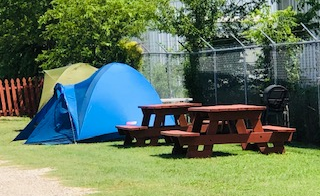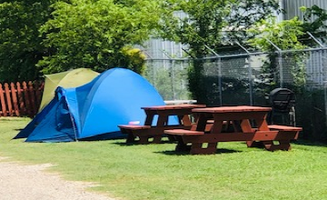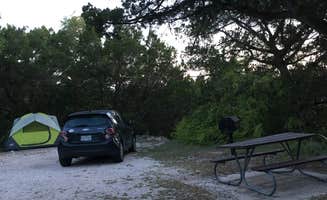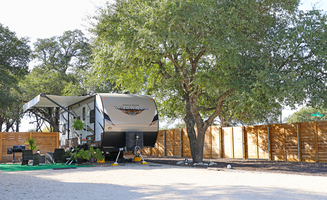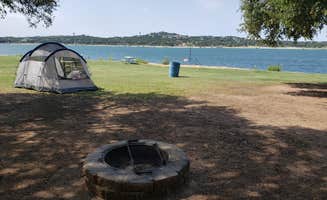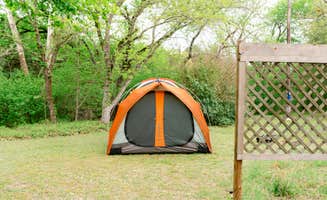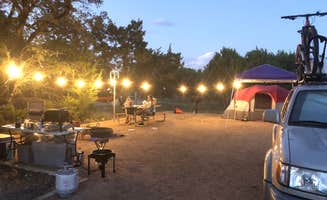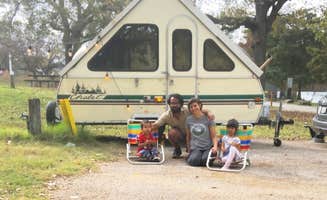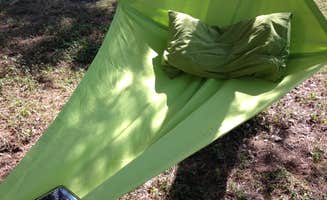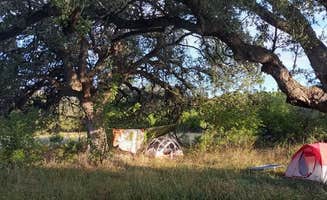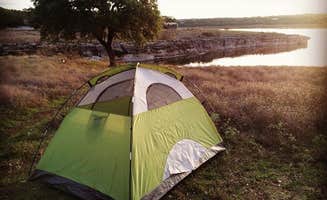Campsites near Cedar Park, Texas offer diverse terrain with elevations ranging from 800-1,200 feet across the area's limestone hills and creek valleys. The region experiences hot summers with temperatures regularly exceeding 95°F from June through September, while winter camping brings mild 50-70°F days and occasional freezing nights. Water levels at lake campgrounds typically peak in spring following Central Texas rainy season.
What to do
Scuba diving at Lake Travis: Windy Point Park features underwater attractions specifically designed for certified divers. "One of the interesting attractions of this park is that they offer deep water access for SCUBA diving. This park is located on Lake Travis and at a location where the shelf drops off steeply into deep water. Just offshore there are some wrecks, sculptures and other objects that may be explored by Scuba divers," explains one visitor to Windy Point Park.
Rock climbing access: Camping sites provide convenient bases for climbers. "We stay at Pace Bend every time we go rock climbing in Austin. The campsites are private and there are always sites available. The campsites along the cliffs are beautiful at night," notes Katie B. in her review of Pace Bend Park.
Winter hiking options: Cold-weather months offer comfortable trail conditions with fewer crowds. "Stayed here on Monday, December 21 (winter solstice) 2020. There were only four other campsites taken. It was very quiet. We went mountain biking in shorts the first day and a backpack training hike the next. Nice trails," shares Rick from his Pace Bend Park experience.
Seasonal creek swimming: Water levels determine swimming options at inland sites. At Tejas Park, "depending on the amount of recent rain or degree of drought, the creek is deep enough to go for a wade or a swim. It is also fun to just explore the area around the creek."
What campers like
Cliff-top vantage points: Several campgrounds feature dramatic overlooks. "Was absolutely stunning, it's on a cliff top so your 'backyard' is a small trail to a gorgeous overlook of the lake and adjacent cliffs. I didn't expect to be given this view," reports Juliet S. about her experience at Pace Bend Park.
Spacious sites with privacy: Campgrounds offer ample space between neighbors. At Cedar Breaks Park, "the campsites are of more than adequate size for comfort. The lakefront spots have a very nice view and the others are tucked nicely in amongst the trees. They have very nice shelters with concrete foundations at each site," according to Kenneth H.
Easy access to Georgetown's attractions: Some campgrounds position visitors near local cultural sites. "Georgetown is full of fun activities and great food. Georgetown is home to 'The Most Beautiful Town Square in Texas' and also is an official Purple Heart City. There's reserved parking all over town for Purple Heart Recipients," notes Mark S. about camping at Cedar Breaks Park.
Level RV pads at waterfront sites: Lake-based campgrounds typically offer the most level spaces. At Cedar Breaks Park, "The sites along the outside of the loop have lake views and are level. The sites along the inside are scary unlevel! Some of the big rigs were backed in and jacked up 4 feet or so in front," warns Karen H.
What you should know
First-come camping policies: Some parks don't accept reservations. At Windy Point Park, "there are no reservations - it is first come first served only. However, I was told that they always have space."
Limited shower facilities: Many campgrounds feature minimal bathroom amenities. "The shower and toilet facilities are OK but not great," notes a camper at Jim Hogg - Lake Georgetown, while another mentions "Restrooms are very basic with no hot water. They were clean but a little creepy for showers."
Flash flood risk: Low-lying areas require weather awareness. A Pedernales Falls State Park camper warns: "Made me aware of how serious flash flooding is here. Respect weather warnings!"
Campground terrain challenges: Significant elevation changes affect site selection. "The sites along the inside are scary unlevel! Some of the big rigs were backed in and jacked up 4 feet or so in front. Saw a lady break her ankle stepping out of her camper," reports a Cedar Breaks Park visitor.
Tips for camping with families
Beginner-friendly options: Certain parks specifically cater to first-time campers. "My 5 year old wanted to go camping for the first time. This location is close enough to be near civilization, but feels remote to get the primitive camping experience," writes Steve L. about Tejas Park, adding "Great family spot."
Playground access: Some campgrounds include dedicated play areas. Lauren Z. from Arkansas Bend reports: "We have enjoyed the hiking trails down by the water and the playground for our kids."
Water safety concerns: Parents should monitor swimming areas carefully. At McKinney Falls State Park, a camper cautions: "Please be careful swimming. If you can't swim, please refrain or wear a life jacket. There have been several drownings here."
Wildlife education opportunities: Evening hours bring nature viewing possibilities. Jesse L. at Tejas Park notes: "The coyotes come out at night, but never got close to camp," providing a chance to teach children about local wildlife from a safe distance.
Tips from RVers
Dump station locations: Plan waste disposal carefully. At Jim Hogg - Lake Georgetown, a camper notes: "Dump station is at entrance of park and park is fairly large to haul a portable dump tank."
Electric hookup variations: Power options differ significantly between parks. At McKinney Falls State Park Campground, RVers have access to both "fifty-amp-hookups" and "thirty-amp-hookups" according to the amenities list, while other parks may offer only one type.
Site levelness recommendations: Strategic site selection reduces setup time. "Big, level site, full hookups," reports Jacob F. about his experience, while another RVer recommends: "I suggest odd numbers 19-35 and even numbers 36-42 as the most level sites with the best lake views" at Cedar Breaks Park.
Access road considerations: Some entrances present challenges for larger vehicles. "Getting in and out of the park was smooth for the most part just watch some overhanging limbs," advises Dan H. about his experience driving a 40' Class A RV at McKinney Falls State Park.


